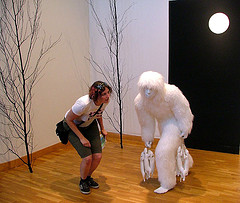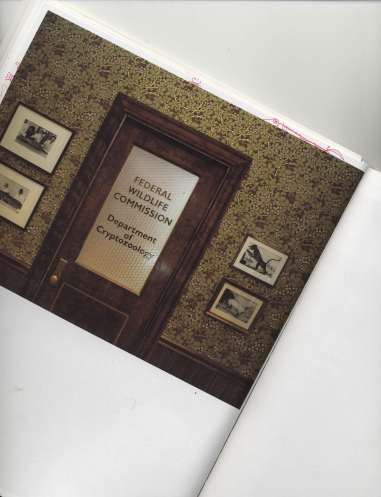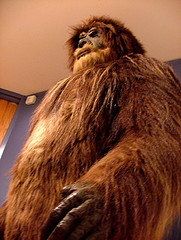
January 16, 2009
When one goes out in -11 degree Maine weather, like I did this morning, to pick up the newspaper, you don’t expect to be surprised with good news quickly. But I was. The top banner proclaimed that a new director of the Portland Museum of Art (PMA) had been chosen. The name and face were extremely familiar.

Photo credit: Gordon Chibroski
It was Mark Bessire (above), the man who had curated 2006’s “Cryptozoology: Out of Time Place Scale” exhibition at Bates College Museum of Art, which had then traveled to Kansas City Art Institute’s H&R Block Artspace. He was the person who was determined to see the exhibition book (Cryptozoology: Out of Time Place Scale) published. Bessire promoted the extended development of the International Cryptozoology Museum, concurrently with the creation of the Bates exhibition.

I had a moment or two, as I was beginning to read the article, where I actually thought, “Jeez, I hope they don’t find out about his links to cryptozoology, or they will take the job away from him.” LOL.

Marc Swanson’s Little Yeti, as photographed by Michelle Souliere, at Bates.
Then, halfway through the article, I was shocked to read the following grounded, level-headed passage tell how Mark Bessire had “organized an exhibition about cryptozoology, featuring the collection and ideas of Portland scholar Loren Coleman.”
Whew. 🙂
Sometimes I naturally lose track, I guess, of how deep an impact cryptozoology has had in zoology, art, cinema, and our popular culture, in general. I often guard against thinking that Cryptomundo, for example, is reflective of the broader world, but then, sometimes a mainstream event like this hiring and how cryptozoology was credited gives me pause and insights into the reality that is growing out there.
So, yes, I am proud to say, cryptozoology has a friend at the PMA, and the world seems a little more hopeful today because of it.

Mark Dion’s installation art, the very official-looking door for the Federal Wildlife Commission’s Department of Cryptozoology, at Bates.
Here, following, is the Portland Press Herald, January 16, 2009, article by Bob Keyes, with the announcement of Mark Bessire’s new directorship. The article also appeared in the Central Maine Morning Sentinel and the Kennebec Journal, covering other sections of Maine. (Images added.)
Mark Bessire, a self-described “museum geek” with deep roots in the Maine art community, was named the new director of the Portland Museum of Art on Thursday.
Bessire, 44, lives in Portland and currently serves as director of the Bates College Museum of Art in Lewiston. Previously, he was director of the Institute of Contemporary Art at Maine College of Art in Portland. He will leave Bates on Feb. 13 and begin his duties at the Portland Museum of Art on March 2.
In an interview, Bessire said he is ready for the challenge. He described his management style as “horizontal.”
“As director, my job is to enable my colleagues to do their best. I need to listen to them and work with them to allow them to do their jobs as well as they can with the resources we have,” he said.
“My first priority is to listen and learn. We’re in a tough economic climate right now, so it’s a good time to be planning and to set our focus on the future. When the economy is bad, it’s a good time to look at the mission and strengthen it.”
The museum’s board of trustees selected Bessire among a large pool of candidates from around the country, said board president Hans Underdahl.
The trustees hired him because “he exudes leadership ability. He really impressed us,” Underdahl said.
“As the search process went on, we decided it was irrelevant that he was local. What the institution needs going forward is someone with a great mix of the scholarly side of it and a strong business background. Mark’s got it.”
Bessire has an MBA from Columbia University, a master’s in art history from Hunter College and a bachelor’s degree from New York University. He was a Helen Rubinstein Fellow at the Whitney Museum of Art in New York and a Fulbright Fellow in Tanzania.
He is a native of Brooklyn, N.Y.
He and his wife, Aimee, live in Portland’s West End. Their two children, ages 10 and 8, attend Reiche Elementary School.
As director, Bessire’s biggest challenge will be navigating the museum through a period of transition during difficult economic times, observers said. A quarter-century after opening its modern Payson wing at Congress Square, the museum faces a host of projects that will shape its image and stature well into the future.
In recent years, it expanded its holdings by purchasing Winslow Homer’s seaside studio at Prouts Neck in Scarborough, acquiring the 1832 Greek Revival-style Clapp House adjacent to the museum and buying a parcel of abutting land at 87 Spring St.
Bessire will be responsible for integrating those properties into the museum’s mission, while maintaining its status as the state’s largest museum. It attracts about 150,000 visitors each year, and operates with a budget of about $4.5 million and an endowment of about $30 million.
The museum employs 46 people full time. It is Maine’s oldest museum, founded in 1882.
Bessire succeeds Daniel E. O’Leary, who retired last May. Thomas Denenberg, the museum’s chief curator, served as acting director in the interim.
Underdahl praised the work of Denenberg during the search.
“He really did a good job – in fact, he did two jobs. Tom took on the responsibility of being acting director while continuing in his curatorial duties,” Underdahl said.
Bessire is known for his background in contemporary art and for making bold programming decisions. At MECA and at Bates, he mounted numerous exhibitions focused on contemporary artists, including Ike Ude and William Pope.L .
He also organized an exhibition about cryptozoology, featuring the collection and ideas of Portland scholar Loren Coleman, and an exhibition about the changing face of China, as told through that country’s emerging and established artists.

Photo: Michelle Souliere, the Bigfoot at Bates.

Bronze sculpturist Richard Klyver, Brazilian exhibition artist Walmor Correa and yours truly, Loren Coleman; photographed by Luc Demers, from the exhibition book, Cryptozoology: Out of Time Place Scale edited by Mark Bessire.

Photo: Professor Hex, the Bigfoot in Kansas City.
At Bates, he administered the college’s large collection of artwork by Maine modernist Marsden Hartley.
As museum director in Portland, he intends to encourage the museum’s curatorial staff to continue to exhibit contemporary art, while finding new ways to showcase its vast collection of American and European paintings from the 18th century to the present.
The museum’s collection is particularly deep in regards to Maine artists, including Homer, Hartley, John Marin, Louise Nevelson, Andrew Wyeth and others.
Bessire said that under his leadership, the museum will never waver from its mission of articulating the role of Maine in American art history, nor will it back off its commitment to showing works by contemporary artists living and working in Maine.
“Traditionally, Maine is known for its landscape. People came to Maine for its light and landscape. Now, Maine is known as a place where artists live and make art. There is still something about the light and landscape that is important to contemporary artists, even if they are not making landscape paintings,” he said.
Bessire’s hiring was widely praised.
Portland gallery owner Andres A. Verzosa noted that Bessire regularly attends the city’s First Friday Art Walks, and is known about town for being supportive of the arts community. “He is young and hip, and committed to Portland. I think it’s very exciting,” said Verzosa, who owns Aucocisco Gallerries.
Jim Cuno, director of the Art Institute of Chicago, has known Bessire for a decade, since Bessire interned at Harvard University while Cuno was there. He said, “Mark will bring vitality, collegiality, a commitment to community and strengthening an already strong institution. It’s only promising for the Portland museum, and I congratulate the museum and congratulate Mark. It’s a perfect marriage.”
Jill Reich, dean of faculty at Bates, said the college was sad to see Bessire leave, but happy that he is staying in Maine.
“He’s done some wonderful things for Bates, our museum and our community, here on campus and in Lewiston,” she said.

Painting from the Bates exhibition, by Alexis Rockman.
About Loren Coleman
Loren Coleman is one of the world’s leading cryptozoologists, some say “the” leading living cryptozoologist. Certainly, he is acknowledged as the current living American researcher and writer who has most popularized cryptozoology in the late 20th and early 21st centuries.
Starting his fieldwork and investigations in 1960, after traveling and trekking extensively in pursuit of cryptozoological mysteries, Coleman began writing to share his experiences in 1969. An honorary member of Ivan T. Sanderson’s Society for the Investigation of the Unexplained in the 1970s, Coleman has been bestowed with similar honorary memberships of the North Idaho College Cryptozoology Club in 1983, and in subsequent years, that of the British Columbia Scientific Cryptozoology Club, CryptoSafari International, and other international organizations. He was also a Life Member and Benefactor of the International Society of Cryptozoology (now-defunct).
Loren Coleman’s daily blog, as a member of the Cryptomundo Team, served as an ongoing avenue of communication for the ever-growing body of cryptozoo news from 2005 through 2013. He returned as an infrequent contributor beginning Halloween week of 2015.
Coleman is the founder in 2003, and current director of the International Cryptozoology Museum in Portland, Maine.
Filed under Abominable Snowman, Artifacts, Bigfoot, Breaking News, Cryptotourism, CryptoZoo News, Cryptozoologists, Cryptozoology, Media Appearances, Men in Cryptozoology, Museums, Pop Culture, Yeti